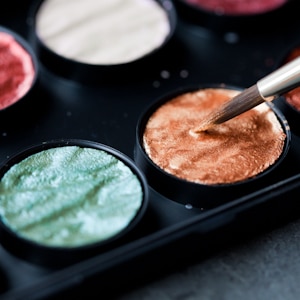The Blog Library
How to Respond to Clients’ Negative Self-Image
 When I put out a Q&A call to my email list a few weeks ago, I got some great questions. This one, I think, deserves special attention and at least two posts. Let’s dive in:
When I put out a Q&A call to my email list a few weeks ago, I got some great questions. This one, I think, deserves special attention and at least two posts. Let’s dive in:
Q: What is the best way to deal with clients (usually women) who love the picture in general, but then make rather harsh comments about themselves? For example, they love everything about the family photo, from the location to the lighting to their kids laughing faces and they gush about that, but follow it up with, “If only my arms weren’t so saggy.” I feel lame just saying, “No, you look great!” but I don’t know what else to do.
A: This is the photographer’s nightmare version of the stereotypical wife asking her husband “Do these jeans make me look fat?”
What a minefield!
When this issue comes up in photography forums, many get hung up on discussions of posing and retouching. And those are totally appropriate and relevant topics. But no matter how carefully you pose someone, or how tastefully you retouch an image, there will always be clients who make self-conscious comments about how they look.
When comments like this come up, it does feel lame to simply disagree with the client. And in fact, when you disagree with people, they usually dig in their heels and become even more convinced that they’re right.
Whenever possible, I avoid responding at all. In some cases, silence is the best strategy, and the comment is lost and forgotten in the natural stream of conversation.
However, sometimes ignoring the comment will make the client feel like you’re giving tacit approval to their statement – making things ten times worse!

My solution, if silence is not an option? Redirect.
There are two parts to an effective redirection: Tell them what you perceive, then bring in a positive emotion.
“I think you look beautiful/handsome and happy to be with your family.”
“I think you look gorgeous and in love with your fiance.”
Etc.
First, when it comes to aesthetics, people can’t really argue with the phrase “I think.” It’s your opinion, and that’s how you perceive it. You are acknowledging that you heard what he or she said, but simply expressing that you see it differently. Sometimes all people need is a little reassurance, and they’ll move on.
Second, refocus their attention on what matters. These images are truly about preserving the joy that they feel together as a family. They’re about making the intangibles of love, memory, happiness, and meaning into a tangible product. (Don’t we have the best job in the world?)
Thus, the second part of your statement should be a comment highlighting the strong presence of one of those intangibles. I doubt anyone is going to argue back and say “No I don’t look like I’m in love with my husband!!” They may still hate the way their arms (or legs, or hair, or nose, or lips, or chin) look, but that’s truly out of your hands. Highlight the emotion, and move on.
As always, I’d suggest dealing with these (and all) issues before the session, wherever possible.
A client once wrote to me saying she was concerned about how she might look in the photos. I wrote back and assured her that all my clients experience these concerns, that these feelings are totally normal, but they’re usually forgotten once we start having fun during the session. I gently reminded her that in reality, we are usually the only ones who see the things that bug us most anyway – no one else is going to notice. Others just see the happy person they know and love. I finished up by saying that while small details seem important in the moment, ultimately these images are more about her relationship with Mr. Client, and capturing the happy emotions she feels when she’s with him. She resonated with that reply and felt better. No problems thereafter.
Bottom line: We all spend a lot of time looking at ourselves in the mirror. Thus, we’re each an expert on how we look. We know our “best angles” and notice any tiny deviation from that best.
Those deviations are simply going to bug people – there’s no way around it. Redirect their attention and try not to dwell on it. If they don’t want to buy that image, just cheerfully say “okay!” and move on.
I have a specific blog strategy that also helps me address these issues. It’s easier to talk about body image broadly, when no one feels singled out. There are also several things you can do to encourage an atmosphere of acceptance within your brand. I’ll share more about that this week….



I had this come up recently with a family session. I love your advice on how to handle it! The mom had a 2-yr old and was four months pregnant with her second baby at the time and just complained about looking “fat.” I told her that when I looked at the photo, I saw a happy mom, having fun one-on-one with her little girl before the new baby arrived. I followed it up with “and 20 years from now when your daughter looks back at these photos, I bet that’s what she’ll see too.” She actually smiled and later told me that photo had become one of her faves! You are absolutely right about redirecting – it definitely helps to bring them back to something positive.
Thanks Stephanie! I think you handled that situation beautifully – as evidenced by the change in how she felt about the image. 🙂 That’s great service you provided. Nice work!
Great insight!
Thanks! 🙂
Very excited to read the “continuation” of this post during the week!
Thanks Kristi! Finishing it up now…. 🙂
Can’t wait to read more. I was wondering how to redirect if it is a single shoot.
Thanks Melanie! That’s a great question. Redirecting is somewhat harder if it’s a single shoot. I usually try to prep in session for that – I’ll put a big smile on my face and do lots of confidence building, and make sure they are having a great time. That way they can remember those positive emotions later.
Of course, if it’s a single shoot, you have more control over how the person moves and is posed, and you have more time to consider and line up each shot – which does make it easier to create a product they’re more likely to like. Depending on the person, you can show them good shots on the back of the camera and see how they react right in session. Combined with a good experience, the image review session goes a bit smoother. You also have more shots to choose from in a single shoot that show that one person at their best – in a family session with so many moving parts that it’s harder to manage everyone looking their 100% ideal in every single shot, so that’s where it’s more of a problem.
Hope that helps …
Thanks for this post and the advice! I’m a wedding photographer, but also provide boudoir photography which is my strength yet all the negative self-image feedback I get has me burnt out and, quite honestly, very SAD! I don’t like the way us women tear ourselves apart when what I see is beautiful and happy faces looking back at me through my lens.
I just ran across your blog & quickly subscribed! I love your unique psychology perspective. This situation seems to happen so often–even with men sometimes! Your response idea makes total sense, and hopefully next time something like this happens I will not seem so awkward with my response. Thanks!
-Emily
Hi
I usually shoot product, but this issue does bug me when I happen to shoot portrait. Any other advice? I have this particular client with really negative self-image, and who is overly sensitive whenever anyone makes the slightliest comment about his appearance (which I often have to do when choosing clothes and posing). I try to be sensitive, but what else can I do?
Great ideas! Redirect your client into remembering joyful memories and emotions rather than perceived negative attributes. I need to implement this in real life too!
I think this is Amazing and thank you for your thoughtful advices. you really put in work in engaging with your audience via your blog posts!
(did I do it right?)